This is one of several pages relating to the history of the automatic totalisator, its invention in 1913, the inventor George Julius and the Australian company he founded in 1917 which became a monopoly in this field and later became part of an oligopoly. If you wish to start from the beginning then go to the index
Copyright © 2007 Email - totehis@hotmail.com
The Kota Kinabalu Installation
Recently Peter, one of the Kota Kinabalu installation team members, retired and I scanned several photographs taken on this project for his retirement farewell.
I decided that it would not be a great deal more effort to present some photos from this project on the Internet.
In 1984 I was seconded to work on an installation in Kota Kinabalu. KK has an interesting history as the city was
virtually built on top of Jesselton, which was obliterated during World War Two. The initial installation team consisted
of Alan Rose installation engineer come site manager, Peter Nelson, the TIM (Ticket issuing Machine) expert
and trainer of local technicians and myself Brian Conlon, sent to guarantee component level repair of the transaction processors,
the mass storage devices and other computer room peripherals. My role existed as it was predicted there would be a
lot of problems in this area as the system had spent 18 months boxed up in crates due to political delays. This was a
time when systems were far more reliable when left permanently turned on and suffered from long periods of inactivity.
A second factor was that systems of the time went through a definite burn-in period when some component failures could
be expected in the early period of first use. Usually systems spent time in the
ATL factory being used for software development prior to being installed on site. By that time the burn-in period was
over and all the marginal components replaced resulting in a more reliable system being installed.
The Systems Department which was responsible for software development, installation and hardware support faced a constant
dilemma related to staffing. When there was more than one project active they were understaffed and during lulls they were
overstaffed. They found that the impact of being understaffed could be minimised by calling on resources in the operations
division if operations were not in a busy period. Peter was employed by Victorian operations and I was employed by Queensland operations.
I consider this installation to be different to most. It seemed to be more relaxed.
The hours resembled normal working hours and we left the racetrack during daylight hours and had week ends off. All other projects I have been associated with
have a critical path analysis and associated uncompromising timetable and rigid deadlines.
When it looked like we were not going to achieve a deadline, Alan announced that he would see the customer and fix it.
The customer is usually the prime drum beater.
I was sceptical thinking here comes the long hours and week end work. Off Alan went, very confident and later, casually informed
us that opening day was put back two weeks "no problems". Perhaps one reason for the relaxed
approach was that this was a brand new racetrack out in the countryside whilst we had an existing system operating at a
city racetrack.
When we arrived at the airport in KK, we were asked to participate in a survey. The local authorities were very interested in promoting tourism and consequently were interested
in finding out what it was that was bringing people to the city.
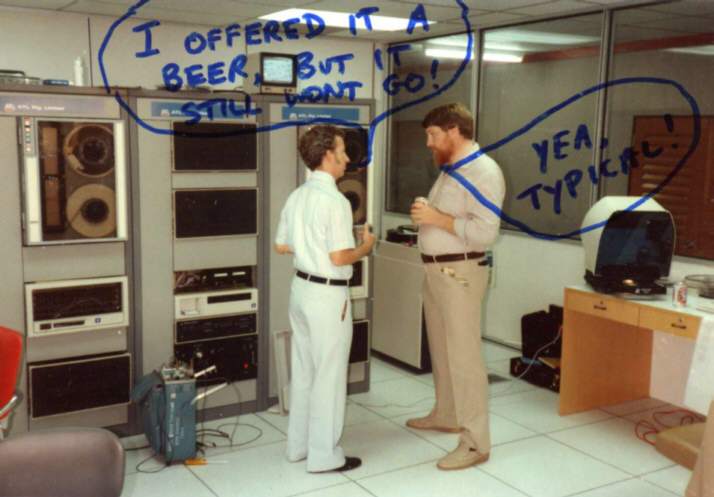
Peter on the right and myself in the KK Computer Room
When this photo was taken, I had just finished repairing a difficult fault. Peter was commenting that he found it
strange that I had spent one long day and
a half in the computer room with my head in a computer or glaring at a CRO (Cathode Ray Oscilloscope visible in a blue case
on the floor in front of the computer racks) without coming out during working hours.
People often think that repairs are fairly quickly performed. Module or item replacement repairs are. Generally when
performing component level repairs and you maintain
a specific piece of equipment of which there are many, you start out applying an analytical process to identifying
problems as there is no other way to arrive at a solution. This is time consuming.
As time progresses you record these problems and you build a collection of faults and solutions and eventually you get to a
stage where very few
problems need to be analysed as you can relate symptoms directly to solutions for problems that have been experienced before.
Achieving this end, repairing repetitive faults becomes quick. I found, on the other hand, with the diverse and extensive electronics in these
computer rooms, which generally only had two of everything, there was not much repetition of faults.
The burn-in related faults and faults caused by unduly high ambient temperatures, resulting from air conditioning problems,
producing thermal runaway events in semiconductors did
not seem to produce repetitive problems. They always seemed to be something new and requiring an analytical approach most times.
Lightning damage on the other hand produced very predictable results with transceivers the main casualties with some
UARTs and USARTs. If the systems were mobile as in Brisbane this would increase the number of problems. Maintaining the TIMs
of which there were normally a significant number, became highly repetitive and after approximately a year in Brisbane, we had
a record of faults from which most of the ongoing faults could be directly related to solutions.
Back to the photograph, the fault on this occasion was in one of the two PDP11/44 processors rendering it totally unusable. The
faulty Integrated Circuit was a BCD (Binary Coded Decimal) counter in one of the sequencers. This was close to the maximum
time I have spent on finding a faulty component.
Alan looked after us during this project. We were staying at a quality hotel in the CBD. Alan discovered that a new palatial hotel
was about to open called the Tanjung Aru. He immediately made plans to transfer us and quickly brought this to fruition.
We certainly enjoyed our stay there. I do not think I have ever slept in such a large bed. I am on the short side which must
have made the bed appear even larger. I recall being woken up late one night by a telephone call. I groped around in the dark
trying to find the bedside table to grab the telephone handset. I eventually realised that I was not getting anywhere and
from my present position in the bed I had no chance of reaching the phone and that I would have to crawl over to the side of the bed.
On becoming fully awake, I eventually ended up scrambling across the bed to reach the phone in time.
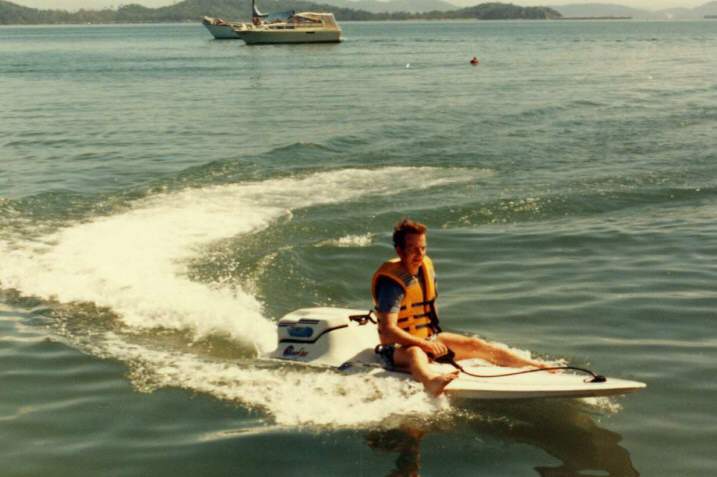
The author attempting to tame a surf board.
Alan also ensured we had time for leisure. We went sailing one day on a catamaran and spent another on what I can only describe as
surfboards with outboard motors shown in the photo. These were not easy to control as there was no seat, were
difficult to hang on to, had no rudder and were capable of impressive acceleration. The South China Sea struck me
as amazingly calm with a mirror like surface. Despite this, the slightest ripple would
fling you into the water if you were travelling at a reasonable pace.
I received a pen from the project management as a memento of this project and recognition of my contribution as I did not
work for the Department that performed these installations.
The pen was engraved “Servo alignment tool” which was technologist
humour as are the annotations on the computer room photograph shown above. I used to carry around a tweeker in my breast pocket. This is a
small screwdriver with a clip that makes it look like a pen. It is used to make fine adjustments to pots
(potentiometers), variable capacitors and variable inductors on PCBs (Printed Circuit Boards). The blade of the screwdriver
is recessed in the outer plastic shroud, so that when it is used to adjust these components, which are always in
close proximity to other components and the printed circuit board, the metal blade does not slip and short circuit
anything. I had performed a reel servo alignment on one of the Pertec magnetic tape drives whilst on this job and
this must have triggered the name chosen for my presentation pen. Pertec tape drives are visible at the top of the left and right
racks in the computer room photograph. The tweeker mentioned is visible along with a biro in my
shirt pocket in the birthday cake photograph below. A servo is an electronically controlled mechanical device. The Pertec
magnetic tape drive mentioned above has a supply reel servo and a take-up reel servo both of which move tape at an appropriate
velocity to keep up with the capstan which has its own servo which controls the tape movement speed.
One week we noticed something new. A squad appeared in tennis outfits, white shorts, white t-shirts and white sand-shoes.
They were obviously training, jogging together around the premises. Initially we were puzzled by this new daily activity
and eventually were informed that the King was going to visit this brand new racetrack and the men-in-white where the new
security team.
Later when our full complement of staff had arrived our number had grown to 5 and the King's visit drew near. Another security
guard came to the computer room one day when we were all present. He did not appear to be one of the men-in-white and was
dressed in a suit. I presumed he was one of the King's personal guards. He spoke very broken English, which left us
with very little means of communication. What ensued resembled a game of charades. We had previously been told that during
the King's visit we would have to remain in the computer room and this combined with the charade resulted in a conclusion
that this is what he had come to talk to us about. I was surprised that a couple of the installation team members became
quite adamant that this was not acceptable. I became amused, at the diligence being applied in conveying to him that
being locked in the computer room for the duration of the visit was not going to happen, especially considering the very
limited level of communication. The security guard was a big man and fortunately very patient. I thought nothing of being
in the computer room for the duration after all I was the odd one who sits there normally with his head in a computer.
Disbelief started to creep in as I realised that no amount of persistence was going to convey to the security guard what
we were trying to say let alone convince him that we would be wandering around the track. As I started to think that this
was going to be a very long interchange without the assistance of a translator, the security guard found a very effective
solution to the problem. He opened his lapel and pointed to his shoulder holster. Suddenly he was confronted with a room
of nodding heads. Yes we will be in the computer room! I do not know what the message really was however I think he had
said that the guards are armed and that it may not be clear that we are not a threat unless we are in the computer
room.
When the King visited KK he also stayed at the Tanjung Aru and we were all treated to non-stop traditional
Malaysian music piped through the corridors.
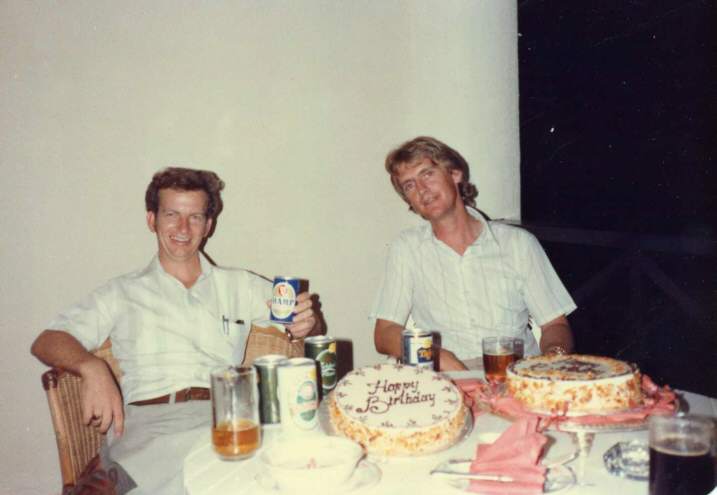
Alan on the right and myself with the two birthday cakes. Photo by Peter
My birthday was during this time away. Alan and Peter decided to celebrate this in my room. Alan was the first to
arrive and we started on the Harp beer. After about 10 minutes there was a knock on the door and Alan exclaimed “my
goodness that was quick”. I had no idea what he was talking about. When I opened the door, room service wheeled
a birthday cake through the door. When we resumed our conversation Alan said he had only organised it minutes
before arriving at my room. Half an hour or so later another knock on the door. Again I opened it and again a
birthday cake was wheeled through the door. This one was the one Alan organised. When we enquired about the
second cake we discovered that the hotel policy was to check for birthdays when they viewed the passports of
guests, which they were obliged to do and provided cakes for quests who were at the hotel during their birthday.
I suspect I can speak for Alan and Peter as well, when I say I found out that having nothing but cake and beer for tea
leaves you regretting it the next day.
 Go back to the index
Go back to the index
 Go to the bottom of the page
Go to the bottom of the page
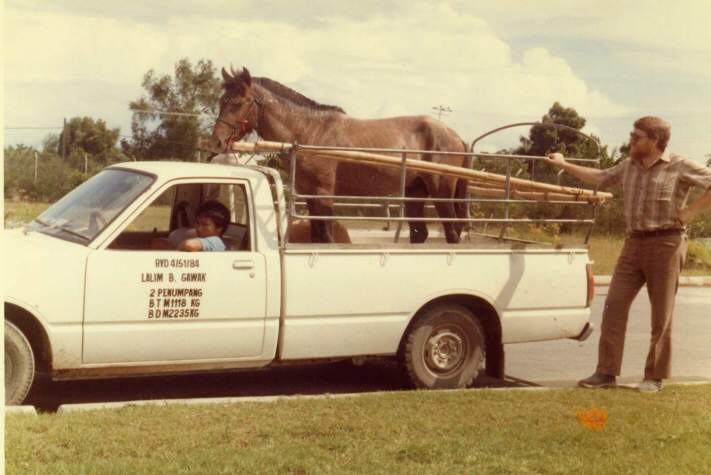
Peter admiring the local racehorse. Photo by Alan.
Alan found the horses particularly interesting and judging by the photo so did Peter. They were not the Arabian breed we are accustomed to and were quite diminutive
in comparison. They were transported two at a time in a vehicle resembling an Australian Ute, something I have never
seen before. One horse was already removed by the time this photo was taken.
Regular installation team members used to prefer eating out at small local restaurants rather than the international
hotels with their traditional Western fare. Having heard all the stories about possible gastric complaints,
I preferred to stay away from the local eating establishments, especially after seeing the dishes being washed out
the back street in the gutter. I was often overruled with the selection of dining location and on these occasions
I preferred a dish called “Steam Boat” as you could boil the items you ate to your heart’s content. On other trips to
South East Asia, my bland dietary tastes made me a source of amusement and I was offered rather exotic dishes to try. After
assisting with a project in Manila, I was awarded a culinary certificate, humour aimed at my lack of adventure in this
regard.
On one occasion when I was being overruled as to where to dine in Singapore, we went to an open dining food court
across the road from the Westin Plaza Hotel (now part of Raffles). As I recall this was in the park however last time
I was in Singapore the food court was gone. As we walked into the mass of outside dining restaurants we were accosted by
people soliciting us to dine at the restaurant of their bidding. We walked with this group following us and barraging us with
restaurant names. As we seemed indecisive most of them left us for more hopeful prospects, yet one remained. He wanted us to go to what sounded like
"Scouts". One of the ATL employees in our group John Pickering, was based in Singapore and took it upon himself to deal with this
persistent solicitor. He started with casual comments like "we're just looking" leading to more elaborate explanations of why
we were not doing as suggested. Our "Scouts" proponent eventually asked the question "are you meeting someone" and John
quickly answered yes which was not the case. I thought that this could become rather interesting but before the next obvious
question was asked John added "only we haven't decided who yet". This tickled our funny bones and the ensuing raucous fits of laughter resulted in our solicitor leaving to search for better prospects for "Scouts"
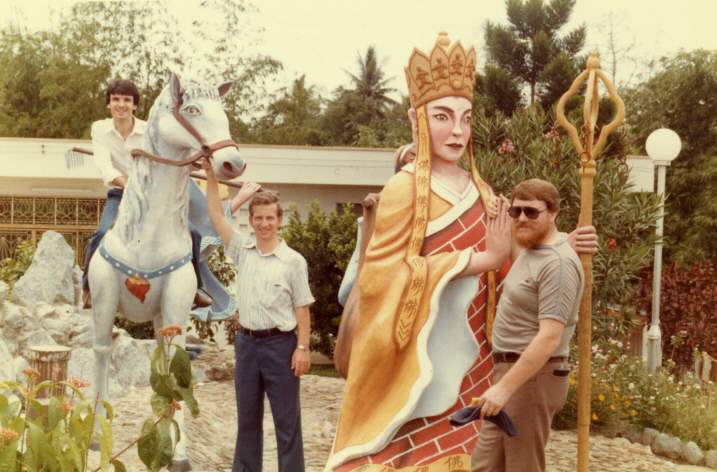
Statues at a Chinese Temple. Nick is riding, I have the bridle and Peter is greeting the Monk.
On one of our days off we went to a nearby Chinese Temple. Outside there were impressive, larger than life statues.
These seemed reminiscent to me of a television show I used to casually watch. It was called Monkey Magic which was
based on a Chinese novel called Journey To The West. It relates to a legend of a Buddhist Monk's pilgrimage to India
during the Táng dynasty. Two of his disciples were Sandy and Pigsy. I asked one of the English speaking locals if this
had anything to do with the statues and was surprised to hear that it did.
Nick D'Angelo had joined us as the hardware installation had progressed to the stage of requiring the installation of software which Nick was performing. Nick was a long serving Systems Manager.
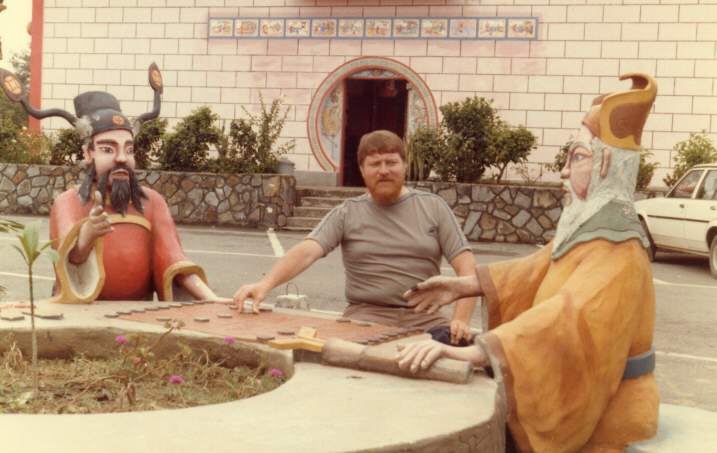
Peter hustling a couple of the locals.
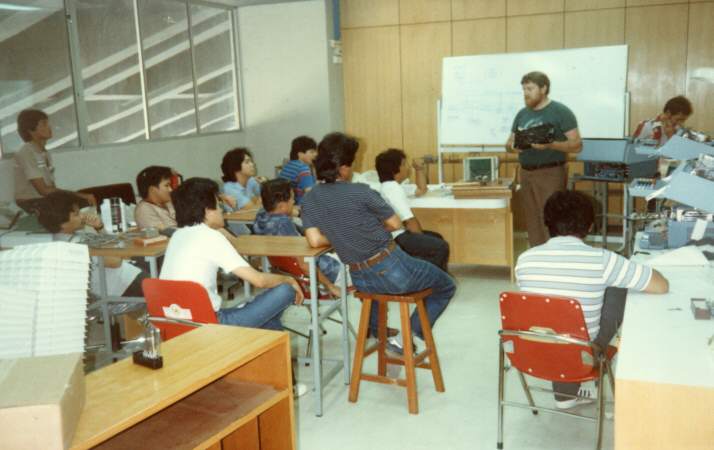
Peter conducting TIM training for the local technicians.
The raceclub had a solid technical staff including two engineers
trained at Birmingham University.
From superficial observation the technicians exhibited what appeared to be an interesting cultural trait. They performed tasks
in unison rather than individually. This was probably beneficial whilst training however if sustained this would have been unnecessarily inefficient.
Three of the Ticket Issuing Machines can
be seen on the right hand side of the photograph. They are blue and are open exposing the electronics bay. The closest TIM
has one of the PCBs (Printed Circuit Boards) on an extender. The PCB is removed and an extender inserted in its place. The
extender has a plug at one end that plugs into the socket on the backplane that the PCB uses. It also has sockets at the
other end that the PCB plugs into for the duration of fault finding. This results in the PCB being totally exposed outside of the case so that it can
be powered up and have the machine working normally whilst giving access to all the components for dynamic analysis so
that the fault can be identified. The tools for this are a multimeter and a CRO. Multimeter brings to mind the AVOmeter. My
goodness does anyone remember them? Amp Volt Ohm meters which have now become the much more compact multimeter sourced
from a plethora of manufacturers. AVOs were comparatively big, heavy and black and always an analogue display.
Having mentioned TIM maintenance above, in the days that we maintained an AWA product called TIM91s back in Queensland, I noticed the TIM technicians
were allowing the number of "hard basket" faulty TIMs to grow alarmingly. This "hard basket" is a set of machines that are deemed difficult to repair
and set aside until there is a lot of time that can be spent on them. This tends to be a misnomer as, in reality this time
never comes and machines in this category tend to end up written off. I started to have a look at these machines and as I
started to repair them a common factor rapidly appeared. They all were suffering from printed circuit track corrosion. The
tracks were oxidising in places and on each of these faulty machines a track had corroded right through causing an open circuit.
These open circuit tracks were all in a different place from TIM to TIM. The faulty tracks were not easily identifiable
through visual means and in the worst case scenario often occurred underneath an integrated circuit requiring a wire to be
used to bridge two more distant points of the track. I have never come across this before in any other piece of equipment.
This corrosion was not a result of leaking batteries.
This immediately explained the difficulty these problems were causing as with this sort of fault, you can replace every component on the board and the
fault will still remain. The printed circuit board itself is faulty requiring repair of a track.
As recreational pilots, Alan and I used to marvel at the spectacular rotor cloud that often formed in the lee of Mt Kinabalu
in the morning. We would get a good look at it during our drive from the city to the racetrack. On this subject
and additionally relevant to cultural traits, a friend of mine John ended up in command of a Boeing 737 in this region flying for
a local airline after being a reluctant participant and subsequent victim of the Australian Pilot's strike. He related
a cultural difference he observed with his local FOs (First Officer). It is a long time ago now and the details have
become hazy however the essence is like this. They were departing an airport where they normally complied with a SID (Standard Instrument
Departure) which specified maintaining the departure track to a specified DME (distance according to Distance Measuring
Equipment) and turning left. On this occasion he received overriding instructions with the take-off clearance to climb
to a specified altitude and turn left. He was flying the aircraft at the time and instead of turning at the specified
altitude he continued on the outbound track towards the position specified by the SID DME.
After recognising the mistake and dealing with it, he asked the FO if he
had noticed the mistake. The FO indicated that he had. The next question was "why did you not tell me". The reply was "You are the
captain, you know what you are doing". My friend said he made it quite clear to this and other local FOs that he
expected them to inform him if they thought something was wrong. He said this never made any difference. My friend
worked overseas for approximately a decade before regaining employment back in Australia.
As a person interested in technology history and ex employee of AWA (Amalgamated Wireless
Australasia) a once great Australian electronics company, I cannot help digressing a little further. The DME mentioned above was developed by AWA in Australia. This operated in the VHF band
and others further developed it in the UHF band which became the standard. The original AWA DME became known as Domestic
DME and the overseas product became International DME and the original faded into obscurity. Similarly AWA were the first
to develop Interscan a multipath precision approach system. I recall working in the AWA North Ryde factory in the 1970s and
the development Interscan aerials were erected in the car park behind the factory. This factory is now gone and there is a
a high rise in the old car park.
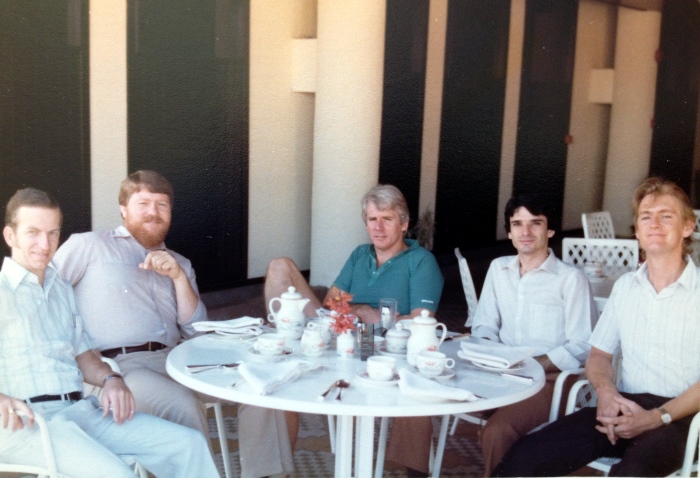
Project Team Tiffin in KK
The above photo depicts one of our more cultured events. The project was near completion and Mike Bell the project manager had joined us on site. From left to right we have myself Brian, Peter, Mike, Nick and Alan. Whilst in KK, Mike received a telegram from Head Office.
Telegram! Does anyone remember the Telegram? Long before the communication phenomenon called the Internet and before making international phone calls became popular, people sent telegrams for brief long distance communications. This was a message sent by telegraph. These were often sent by Morse Code and later Telex machines and ended up written or printed on a piece of paper which was delivered to the recipient's door. You were charged for the number of words so you would keep the message as short as possible. The Telegram had a source and a destination address.
Often a would-be poet amongst the ATL employees would write some words about a project as a good luck wish and this was ours. I have changed the names of the people mentioned in the poem as I have not sought consensus to place this poem on the Internet. Some of the suggested activities in the telegram have nothing to do with the character of the people mentioned and was just written for a laugh, another reason for changing the names. I have reproduced the telegram in capitol letters as the telegram is all in upper case.
TABHOT MA80753
TOTESYD AA22705
TLX 11264 13/4/84
TANJUNG ARU BEACH HOTEL
TO: (GUEST) MR MICHAEL J BELL
FR: ATL PTY LIMITED
FROM THE GANG BACK IN OZ, WE’D ALL LIKE TO SAY
OUR VERY BEST WISHES ON OPENING DAY,
TO ALEXANDER THE BOSS, WELL YOU HAD A GOOD PLAN
IT’S A PITY ABOUT WHAT’S BEEN HITTING THE FAN.
TO WILLIAM, YOU’VE HAD BAD LUCK, WE THOUGHT YOU’D BE SUNK
NOW KEEP CALM AND COLLECTED AND DON’T GET TOO DRUNK.
WELL JOHN BRISBANES MISSED YOU, BOY THAT JOBS A LURK,
WHATS IT LIKE UP IN SABAH HAVING TO WORK?
AND BUONARROTI, SINCE YOU’RE SINGLE AND ANYTHING GOES
HAVE YOU BEEN TO THE CAPITOL AND CURLED ALL YOUR TOES
LASTLY HORATIO, ITS BEEN SAID YOU’LL COME BACK IN MAY
NOW DON’T BRING BACK SOMETHING THAT WON’T GO AWAY
ANON
LOTSALUCK
ANON was Steve Bready who wrote in an email on January 3 2009:
For the record I believe it was Steve Malarky (programmer) and myself who initiated the sending of poems after a major milestone on an installation when we installed the Off Fonton system in Manila. I can remember having a chat with Steve one evening in Manila over a beer (or2, or 3...) about sending a poem describing, in a humorous manner, how the job was going. We were not sure how it would be received by the 'officialdom' at ATL so we sent off one telex querying ATL's policy on earthing for the J22 TIMs and the poem in another telex that we just signed ANON and I think that whenever a poem was subsequently sent it always had that ANON at the end. Both Steve and myself laughed so much when we received a responding telex later from David Macfarlane, who was the Production Manager. I believe it was:
obviously a poet, but do you know it?
Congrats on a job well done!
Re J22 earthin', we must look at the worth in
Safety for Off Fonton.
Have you tried water pipes? Perhaps they'll suffice?
However it must be done!
It was so funny to be exchanging technical information and directives to rhyme. Could this be another first for ATL?
At the time of this installation it appeared that our small installation team that fluctuated between 2 and 5
constituted almost all of the Occidental contingent in the city. During a walk, I was stopped in the street by
5 young men. My first thought was "I am being mugged". The second thought was almost instantaneous "if this is a mugging
these must be the best dressed muggers seen with clean and pressed attire, besides they seem too happy". Next they
started pointing at my camera. As I removed the camera from my shoulder a murky part of my mind wondered if they wanted to steal it.
As I looked up I realised that nothing could be further from the truth. They had lined up in a row with their arms around each other's
shoulder. They wanted their photograph taken! As I focused the camera I wondered how they were going to collect the
print as my camera was not a Polaroid. This was not a problem, for as soon as the shutter clicked, they were on their way.
I do not know what they thought the destiny of this photograph would be, however I suspect that they would be pleased
if they knew it was on the Internet. Despite the fact that we only met for a fleeting moment and no words passed
between us, I often think of them and wonder what their lives are like. I would like to wish them well.
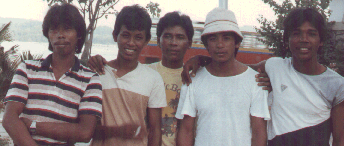
My five new-found friends
It only remains to wish Peter well in his retirement. I believe he will still be called upon to help out during busy periods.
I have heard he is now engaged in a form of trotting different to which he has spent so many years associated with. Globe trotting instead of trotting races.
Comments and suggestions welcome to
totehis@hotmail.com 



 Go back to the index
Go back to the index





